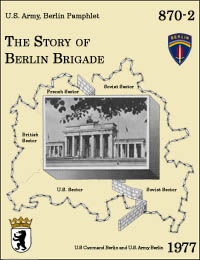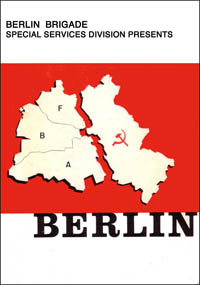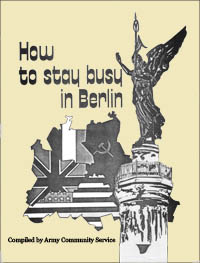Berlin in Détente-era Berlin Brigade Booklets
Jump to the Table of Contents
 |
Berlin in Detente-era Berlin Brigade Booklets and the Story of Berlin Brigade
The historical background behind Reunification: A Monterey Mary Returns to Berlin
This book is a by-product of the research for a “Then-and-Now” novel about Berlin: Reunification: A Monterey Mary Returns to Berlin. The novel is a comparison of Berlin in the 1970s with Berlin in the 2010s, spiced up with the stories of escapades that only those at Field Station Berlin could have pulled off.
The booklets and articles reproduced in this volume define the “Then” of Reunification. They cover the period from 1967 to 1975, spanning the tenth anniversary of the Berlin Wall (1971), my tour of duty with Field Station Berlin, and the beginnings of the short-lived Détente in relations with the Soviet Union. Détente ended after the Soviet invasion of Afghanistan in December 1979, which led to the United States boycott of the 1980 Olympics in Moscow, but that is another story.
The decision to reproduce these booklets and articles was based on a number of considerations. Army in Europe magazine, which provided the two articles that open this volume, is only sparsely held in libraries in the United States. WorldCat (the on-line catalogue of a consortium of libraries, headed by the Library of Congress) only shows four. The Story of Berlin Brigade: U.S. Army, Berlin Pamphlet 870-2 is only held in two, and both of those are military libraries. Furthermore, the editions that they hold are from 1980 and 1981, making the 1977 edition reproduced here “unique,” a word that was constantly used during my tour in Berlin to describe our situation there. (See page 247.) The 1970s editions of Berlin Brigade AG Special Services Presents Berlin are not held in any library, nor are the ACS How to Stay Busy in Berlin, and the U.S. Commander, Berlin’s Welcome to Berlin. Reprinting makes them all available for research libraries to add to their collections.
The second consideration is that—when presented in a single volume—the material collected here has a historical value that is greater than the sum of the individual pieces in isolation. The booklets represent three different perspectives of Berlin: practical, rhetorical, and pragmatic.



Welcome to Berlin: Compliments of the U.S. Commander, Berlin is practical. It presents factual data on Berlin, ranging from Command organizational charts to the biographies of the key players in the Command. Since Berlin Command interacts heavily with the local civilian government, there is an organizational chart for that as well. The booklet also contains a brief history of Berlin, and an overview of the Quadripartite Agreement on Berlin, which entered into force in June 1972.
The “Special Report,” in the September 1967 issue of Army in Europe entitled “East Germany: A Look Through the Wall” is rhetorical. It establishes a rather chilly baseline for the temperature of the war of words that was typical of the Cold War: “The precedent and foundation for Communist dictatorship were already present in Germany. A fascist dictatorship had ruled the country for 12 years. It was no great leap from Hitler to Ulbricht.”
Berlin Brigade Special Services Presents Berlin and How to Stay Busy in Berlin are pragmatic. They present a guide of how to get on with life in Walled Berlin, ranging from the history of Berlin to where to go shopping and sightseeing. This is the point of view of the Americans who actually lived in Berlin, sharing the fate of those whom it was their impossible duty to defend, because—as the CIA Berlin Handbook (1961) says—”the Soviets and East Germans could seize West Berlin at any time.”
Making it easy to compare these perspectives in a single volume is one of the “values added” by reprinting these booklets and articles. Another is that they create a sense of living history. The differences between the various discussions of Berlin allow the reader to see how things changed in Berlin from one point in time to another. This is one of the things that make it appealing for those interested in the history of Berlin to read these Détente-era texts one after the other. There is an index to make a comparison of their points of view easier.
No attempt has been made to re-edit the texts. Only blatant typographical errors have been corrected.
- Berlin Détente-era Chronology (1965-1975)
- Compiler’s Foreword
- “Special Report: East Germany: A Look Through the Wall,” Army in Europe, September 1967.
- “Night Train to Berlin,” Army In Europe, August 1969
- A story of the Duty Train that ran between Berlin and Frankfurt.
- Berlin Brigade AG Special Services Presents Berlin
- A tour of East and West Berlin by Special Services Branch, 1971, with a comparison to the previous edition, highlighting all the changes between the two.
- Welcome to Berlin: Compliments of the U.S. Commander, Berlin
- A Command Information packet promulgated with the “compliments of the United States Commander, Berlin,” over the signature of Major General William W. Cobb, whose command of the American Sector of Berlin extended from 12 May 1971 to 10 June 1974.
- The Story of Berlin Brigade: U.S. Army, Berlin Pamphlet 870-2 (1977)
- The official history of Berlin Brigade and the 6th Infantry Regiment.
- Field Station Berlin
- A chronology of Field Station Berlin, with commentary on its heraldry.
- Index
- Generations of the Wall
Prices for the individual booklets on eBay range from $10 - $25, depending on the condition. At $14.95, the reprint is considerably less expensive. Buy one now.
Also in the Berlin in … Booklets series:
- Berlin in Early Cold-War Army Booklets. This is a reprint of a series of six army booklets on Berlin, covering the period from 1946 to 1958. The booklets are written from a single institutional viewpoint, that of the United States Military Command in Berlin. When read in parallel, the booklets create a sense of living history, because, while they cover the same topics of interest about Berlin, their coverage of these topics changes as the series progresses, and you can see the political relationships of the time change before your eyes.
- Berlin in Early Berlin-Wall Era CIA, State Department, and Army Booklets This is a reprint of three booklets that the historical context of The Day Before the Berlin Wall. They cover the period from 1958 to 1966, spanning the critical year in which the Wall was built: 1961.
While you are here, check out these other interesting links:
The OFFICE OF THE U. S. HIGH COMMISSIONER FOR GERMANY, BERLIN published a booklet entitled A SURVEY OF BERLIN on JULY 1, 1950.
The feature article in the May 1959 issue of Army Digest was on Berlin. Follow me to read it.
The November 1961 issue of Army Digest carried a photo montage of the U.S. Army responding to the Communist challenge on the front lines of freedom in Berlin.
The August 1969 issue of Army Digest ran an article on the Berlin Duty train.
Also by this author: three award-winning Berlin novels:
Voices Under Berlin: The Tale of a Monterey Mary
